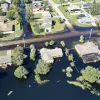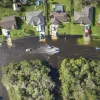Only 7% of Texan Homes Have Flood Insurance. It's Time to Check Your Coverage, Wherever You Live

Homeowners in all states should check their flood risk and insure their homes accordingly.
At the time this was written, around 173 people were missing and 120 confirmed dead in Texas flash floods on July 4. Many victims were children. It was an unimaginable tragedy.
Indeed, it feels almost too soon to be writing about the more mundane consequences of floods. However, it was a reminder of something that can cause genuine misery for all too many homeowners: uninsured flood damage.
The details in what's coming next mostly apply to Texas. But it's relevant to homeowners in every state where flooding can be an issue.
Strikingly Few Texans Have Flood Insurance.
Only 7% of homeowners in Texas currently have flood coverage, despite standard homeowners' insurance typically excluding flood damage, according to the latest data from Neptune Research Group.
Now, many people in Texas do not need flood insurance. The chances of their experiencing a flood are close to zero.
But it's different for many others. The network of rivers in the Hill Country of Texas, where the latest tragedy occurred, is nicknamed Flash Flood Alley, says The New York Times.
But plenty of less obvious places in the state are also at risk. "With more than 2.1 million properties projected to face flood exposure over the next 30 years, and over 200,000 expected to flood with near certainty, Texas is facing a critical insurance shortfall," says Neptune.
Indeed, since the Hill Country tragedy, other parts of Texas have already faced further flooding. "A severe thunderstorm warning and flash flood warnings are currently in effect in North Texas," reported Fox 4 on July 8. "The heavy rains brought flooding and swift-moving water to the DFW [Dallas-Fort Worth] area, requiring water rescues Tuesday evening."
The Voss Law firm in The Woodlands, Texas, said, "The period between about 1 and 2 AM on Monday was the wettest hour in 69 years of hourly data at DFW Airport, as 3.01 inches of rain fell. ... In Dallas alone, there were nearly 200 water rescues and countless disabled cars."
And yet, in Dallas, less than 1% of homes have flood insurance coverage, says Neptune. Meanwhile, "Harris County accounts for nearly 50% of all NFIP [National Flood Insurance Program] payouts statewide, yet over 78% of homes remain uninsured."
We appear to be experiencing many more so-called once-in-a-century and once-in-a-millennium rain events than ever before.
What Coverage do You Need In Your State?
People living atop mountains and high hills can be pretty sure their risk of flooding is minimal. And those in Flash Flood Alley know that their risks are high.
But what about everyone else? How do you know the risk of flooding your home faces?
Well, the standard answer is to consult the FEMA Flood Map Service Center website. But, at least in Texas, this seems inadequate.
"Since 2005, over 52% of NFIP claims in Texas have occurred outside FEMA-designated high-risk flood zones," according to Neptune.
By all means, consult the FEMA maps. But be aware of their limitations. And ask yourself some basic questions. How elevated above sea level is my home? How close to floodable water (coasts, rivers and lakes) is it? Would I cope financially if my home were to flood and I had no insurance?
How Much is Flood Insurance?
Several online sources reckon that the average cost of flood insurance in 2025 is $899 annually or $75 a month. But that is just an average.
In 2024, FEMA said, "37% of policies nationwide fall into the $0-1,000 range, while 32% cost between $1,000 and $2,000 per year." How much you would pay will largely depend on the replacement value of your home, its characteristics (foundation type, first floor elevation, and any flood defenses that exist, such as flood vents), and the likelihood of your having to make a claim, mainly based on the property's elevation, proximity to floodable water, and history of flooding.
You don't have to go with an NFIP policy. Private insurers also offer coverage. So, shop around for your best premiums. Just make sure you check that the one you choose provides the protections you need.
Of course, with so many other calls on household budgets, $75 monthly can be a big ask. But "An inch of floodwater can cause up to $25,000 in damage," says the NFIP and FEMA. And that's likely a best-case scenario. Imagine trying to pay for repairs when the floodwater is feet deep.





